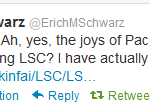
LSC, an Alternative to PacBioToCA for Error-correction of PacBio Reads

We got a heads up from @ErichMSchwarz about LSC, which is a recently published new algorithm for correcting Pacbio reads from Illumina.
Improving PacBio Long Read Accuracy by Short Read Alignment
Kin Fai Au, Jason G. Underwood, Lawrence Lee, Wing Hung Wong
The recent development of third generation sequencing (TGS) generates much longer reads than second generation sequencing (SGS) and thus provides a chance to solve problems that are difficult to study through SGS alone. However, higher raw read error rates are an intrinsic drawback in most TGS technologies. Here we present a computational method, LSC, to perform error correction of TGS long reads (LR) by SGS short reads (SR). Aiming to reduce the error rate in homopolymer runs in the main TGS platform, the PacBioH RS, LSC applies a homopolymer compression (HC) transformation strategy to increase the sensitivity of SR-LR alignment without scarifying alignment accuracy. We applied LSC to 100,000 PacBio long reads from human brain cerebellum RNA-seq data and 64 million single-end 75 bp reads from human brain RNA-seq data. The results show LSC can correct PacBio long reads to reduce the error rate by more than 3 folds. The improved accuracy greatly benefits many downstream analyses, such as directional gene isoform detection in RNA-seq study. Compared with another hybrid correction tool, LSC can achieve over double the sensitivity and similar specificity.
You can find LSC-related thread in seqanswers forum here.
Following paragraph from LSC paper could be helpful for readers:
Comparison of LSC and PacBioToCA
We are aware of only one alternative program for the combined
analysis of LR and SR data. The program PacBioToCA [11] also
makes use of information in SR to correct errors in LR. We
compared the performance of LSC with PacBioToCA (the latest
version on March 13, 2012) on the same LR and SR data sets.
PacBioToCA output 13,995 ecLRs, 13,980 (99.89%) of which are
longer than 460 bp. Comparing with PacBioToCA, LSC has
significantly higher sensitivity as it output a several-fold higher
number of ecLRs in every bin of read length (Figure 5).
We divided the 62,465 LSC ecLRs with sequence identities
higher or equal to 0.9 into 3 groups according to their sequence
identify and read length (L) (Figure 6). Group 1 (I= 0.9665 and
L = 917 bp at average) has 13,995 ecLRs, which is essentially
equivalent to the reads output from PacBioToCA (Table 3).
Group 2 (I= 0.9246 and L= 929 bp at average) has slightly lower
identity but may still be of high quality and should not be
discarded. In order to compare the qualities of Group1 and Group
2, we aligned both groups to the transcriptome and the genome by
BLAT and counted how many known exon junctions can be
detected respectively. From two alignments (against transcriptome
and genome) of each read, the one with more known junction
detections were counted. About the same numbers of true splices
were detected from Group 1 and Group 2 at every bin (Table 4).
Given that the two groups are similar in size, this comparison
indicates that the detection from Group 2 should be of similar
reliability to that from Group 1. By providing this large group of
additional ecLRs, LSC has extracted a larger amount of useful
information to us from the same data.
With an eight-core server (Intel(R) Xeon(R) CPUs, 2.66 GHz)
with 32 G memory, LSC finished the computation within 10
hours and used about 20 G disk space to store temporary files.
With the same machine, PacBioToCA took 81 hours of
computation time and required a much higher amount of disk
space (800,1,000 G) for temporary files. Thus, LSC is considerably
more efficient computationally. The online introduction of
PacBioToCA shows that it is developed originally for the assembly
of small genomes such as E. coli. It is perhaps not surprising that it
is not competitive with LSC in the analysis of reads from the
mammalian transcriptome, a task that LSC was specifically
optimized for handling.